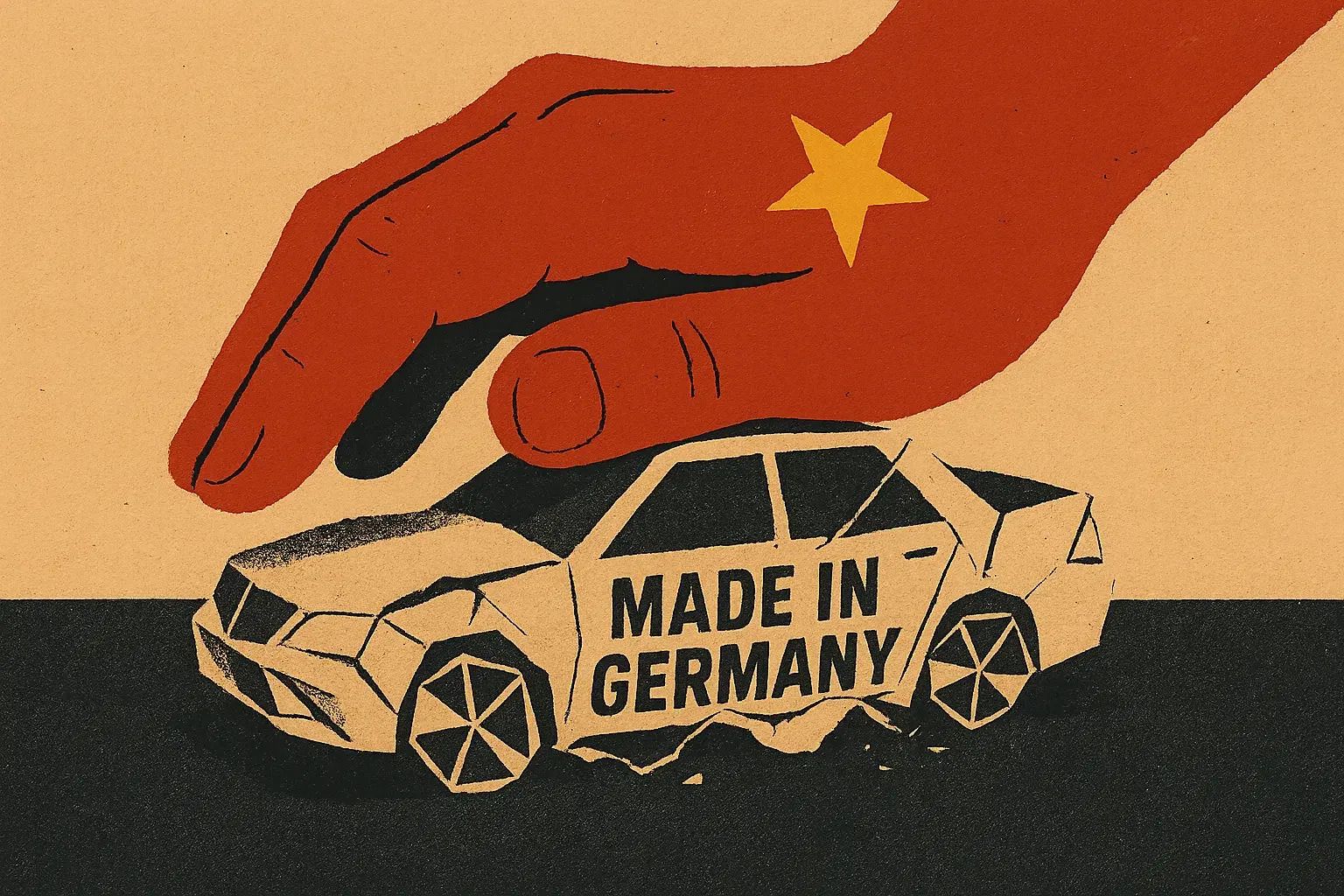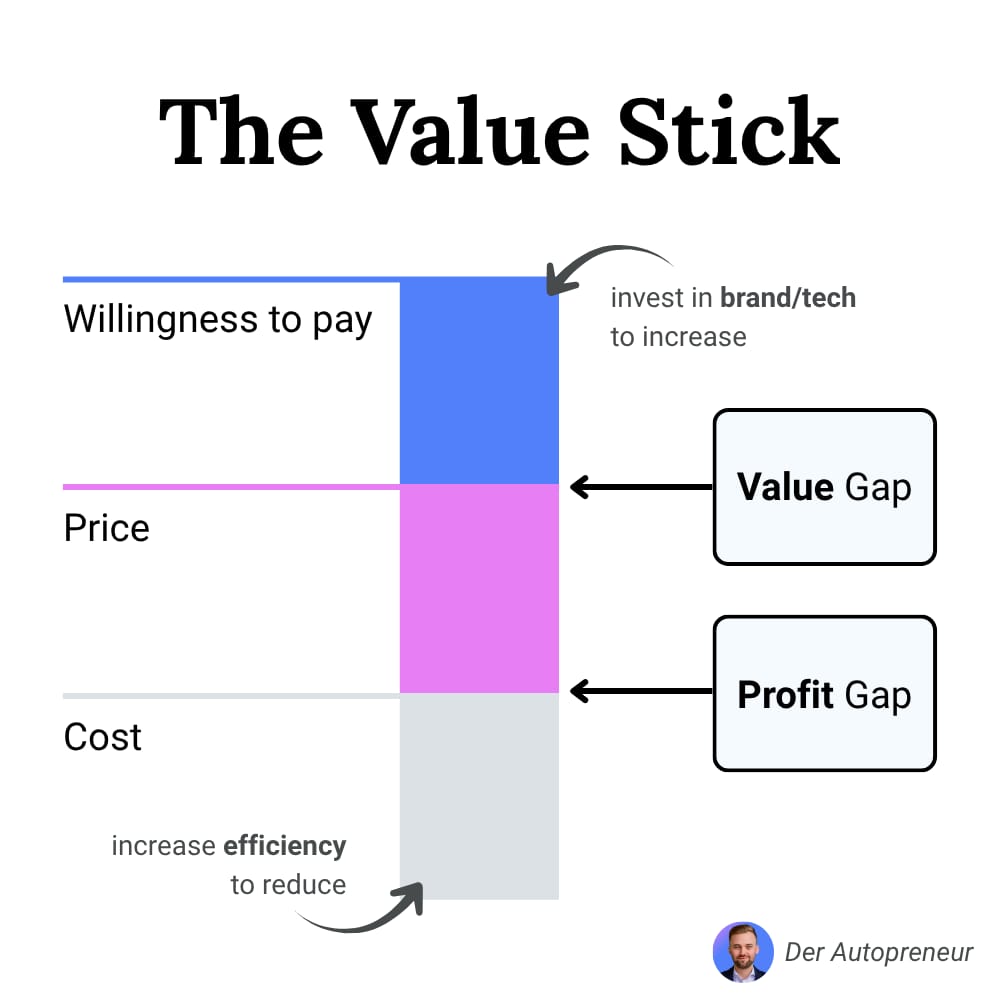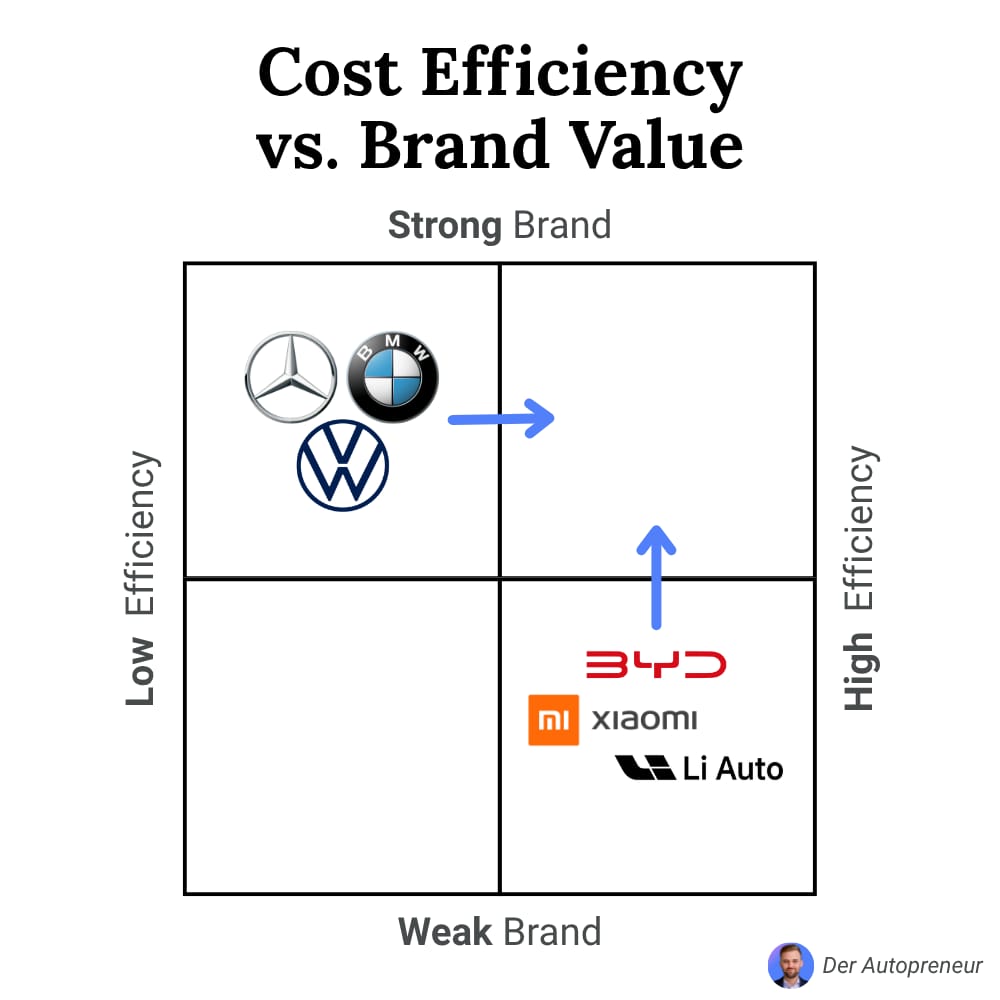- The German Autopreneur
- Posts
- How China kills 'Made in Germany'
How China kills 'Made in Germany'
Welcome to Issue #92 of The German Autopreneur.
In 2007, Apple launched the iPhone. For $499.
Too expensive for a phone, everyone thought.
Today we pay €1,200 for an iPhone without hesitation.
Apple shifted our value perception. They taught us what a smartphone is worth.
Now the opposite is happening with cars. China is shifting value perception downward.
Chinese cars offer the same features for half the price. Western brands suddenly look overpriced.
Today we'll look at how China is destroying the premium positioning of Western automakers. A simple model explains everything. And shows why legacy manufacturers now seem too expensive.

Every Business Strategy Rests on 3 Lines
One model explains almost every business strategy. The Value Stick.
Imagine 3 horizontal lines:
Top: Willingness to Pay - What customers think it's worth
Middle: Price - What you charge
Bottom: Costs - What it costs to make
Between these lines sit 2 gaps:
Value Gap (value minus price): Bigger gap = more attractive to customers
Profit Gap (price minus costs): Bigger gap = more profit

The Value Stick shows the two strategic levers: increasing value or reducing costs (Harvard Business School)
Companies can win in 2 ways:
Option 1: Lower costs. Through scale, efficiency, integration. Then cut prices while staying profitable. This expands the value gap.
IKEA did this. Flat-pack furniture you assemble yourself. Much cheaper. Still profitable.
Option 2: Increase perceived value. Through branding, design, service. Then charge higher prices. This expands the profit gap.
Apple did this. Premium design, strong brand, closed ecosystem. Customers gladly pay more.
Both strategies work. The question: Who does what better?
Let’s take German automakers as an example.
They perfected the value strategy for decades.
They invested heavily in their brands. In the myth of German engineering, quality, prestige.
The result? Strong brands command higher prices.
A Mercedes costs more than a Toyota. Not just because of technology. But because of what Mercedes represents.
German manufacturers justified their premium through 2 pillars:
Superior product: Better engines, precise craftsmanship, premium materials
Strong brand: Status, heritage, emotional connection
These pillars reinforced each other. Technical excellence strengthened the brand. And the strong brand justified higher prices.
This worked for decades. Premium automakers charged more. Customers gladly paid.
Perceived value exceeded the price. The value gap delivered solid margins.
China Is Now Using Its Playbook for Cars
Then China entered with a different approach.
The same playbook that worked in other industries.
They focus on cost leadership. Pushing costs to levels Western manufacturers can't match.
How?
Battery integration: BYD makes 90% of its batteries in-house. Cuts costs by 50%.
Development speed: 1.3 years per model vs. 4 years for traditional automakers. Less time = lower costs.
Supply chain clusters: In Shanghai, manufacturers get all components within 4 hours. This minimizes logistics costs. And creates speed.
Scale advantages: China sold 11.5 million EVs in 2024. Europe sold less than 3 million. Higher volume = lower unit costs.
The result? Chinese EVs cost 20-50% less than comparable European models.
And China passes these savings to customers.
Lower prices. Bigger value gap.
Chinese Cars Are No Longer Worse
The equation used to be simple. Chinese cars were cheaper but worse.
Not anymore.
Chinese EVs now match European models on every metric. Top safety ratings. Advanced driver assistance. Premium materials. Over-the-air updates. Luxury features that cost thousands extra at traditional brands.
In some areas, Chinese cars are better. Software. Digital features. Range per euro.
Example: The Xiaomi SU7 offers more digital features than a Porsche Taycan. At one-quarter the price.
Scott Galloway calls this the "good enough" strategy. Deliver 80% of the premium product at 50% of the price.
That's what Xiaomi does with cars. They deliver most of what makes a Porsche special. For less than half the cost.
For many customers, that's enough.
How Value Perception Shifts
Here's where psychology takes over.
New competitors offer good enough features at much lower prices.
At that moment, something shifts in customers' minds.
The price anchor moves down. Customers expect lower prices. Their willingness to pay drops.
The old premium suddenly looks overpriced. Customers question what they're paying for.
The story used to be clear: European cars cost more because they're better. Better technology, quality, craftsmanship.
This narrative is collapsing.
Features are comparable. Technology is on par. Sometimes even better.
What's left? The brand. But does that alone justify 50% more?
China Is Now Building Brand Too
Now comes the real threat.
Western companies always excelled at branding. They built strong brands to charge premium prices.
China always excelled at cost reduction. They replicated Western products at a fraction of the cost.
They won on price. But their brands stayed weak.
This is changing.
Through technology leadership, Chinese manufacturers are building brand value for the first time.
They might soon have both. Cost leadership AND strong brands.

German brands have strong branding but high costs. Chinese brands are efficient and are now building their brands (own illustration)
How European Automakers Are Responding
European automakers have recognized the problem. China combines low costs with growing brand value.
They're responding in 3 ways:
1) Raising perceived value
They lost their technology edge. Now they're investing to catch up. Especially in software.
The goal: Regain technical superiority.
The challenge: It's a race. While they catch up, China keeps advancing.
2) Cutting costs
Job cuts. Savings programs. Plant closures. We see it weekly.
But structural disadvantages remain. European energy costs are twice China's. Labor costs 4x higher. Development takes much longer.
They can't match China's cost structure.
3) Focusing on the premium segment
Focus on the highest end. Protect the brand built over decades.
The risk? They lose volume. Lose economies of scale. And lose an entire generation of buyers.
My Take
The Value Stick model shows what's happening.
For decades, European brands rested on 2 pillars: Superior technology AND strong brand.
Now one pillar has collapsed.
Tech leadership is gone. In some areas, Chinese brands are better.
Only the brand remains. But that alone can't justify 50% higher prices.
China shifted the price anchor down. And the entire value perception with it.
The real threat: They're building brand value through technology leadership. For the first time, they could have both cost advantage and strong brands.
Traditional automakers must fight on 2 fronts. Cut costs. And defend perceived value.
What doesn't work: High costs with no real premium story.
And what premium means? That’s no longer defined within Europe.
That's all for today.
What did you think of today's email? |
Feel free to reply to this email with your thoughts.
All the best,
Philipp
PS: If you find value in this newsletter, please share it with someone who might benefit. Your support helps me continue my independent work for the automotive industry.

